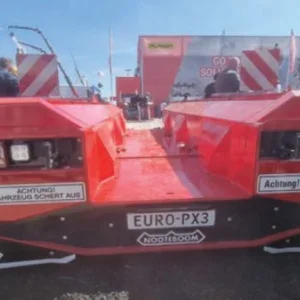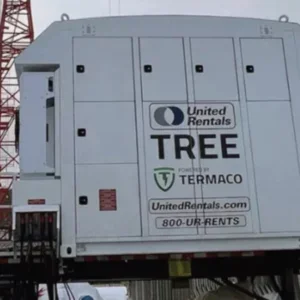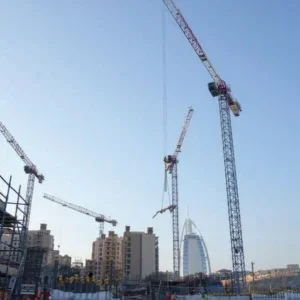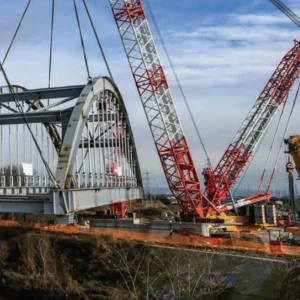On Thursday January 18, the MSC Napoli was damaged in a storm in the English Channel. By that evening, the English Coast Guard reported that a salvage contract was agreed and awarded to a consortium of Smit International, lead contractor, and Les Abeilles and Klyne tugs.

The Bigfoot barge approaches the Napoli
The vessel was towed from the middle of the English Channel, where it was freely drifting, and grounded in the more sheltered Lyme Bay, where salvage operations would be easier, to avoid the risk of the vessel sinking in deep water. The plan was to remove all of the fuel and cargo weighing the boat down, and to refloat it.
Smit subcontracted Dutch subsidiary of Belgian lifting group Sarens to supply cranes. Sarens got the green light the next afternoon, and on Saturday morning received the 130m-long Bigfoot barge alongside its Dordrecht quay for outfitting.
“In the beginning, it was a critical path process to get the job organised,” says Rutger Kouwenhoven, general manager, Sarens Netherlands. With its own cranes, Sarens loaded the barge with mats and equipment, and installed a 600t capacity Demag TC 3200 truck crane with 60m lattice-boom on outriggers. It also placed a 250t capacity Sumitomo SCX 2500 on the barge.
Sarens treated the cranes with Tectyl Valvoline grease spray and covered the crane bodies with plastic to protect them during the journey across the English Channel. The barge shipped out on Wednesday, said Zodiac Maritime Agencies, managers of the Napoli.
By Friday, less than a week after the ship first ran into trouble, the barge had arrived at the Napoli, and moored to its sheltered port side.
Bigfoot met up with a smaller barge, Boa Barge 21, which had been brought from Rouen, France. The 4,400TEU capacity MSC Napoli was carrying 2,394 containers when it ran aground, and 103 washed overboard.
At sea, before lifting could begin, the crew needed to clear the worksite. The Coast Guard reported that the Napoli’s spilt oil had created a slick three to four miles long. The ship, and several local rivers, were isolated with floating plastic guards that prevent the oil
from spreading.

The crane, rigged with superlift, lifts submerged containers off the vessel
“The first challenge at the site was to get the bunker fuel out of the vessel from all of the underwater tanks,” says Bert Kleijwegt, Smit senior salvage consultant, who is supporting the offshore operation. That included pumping out tonnes of oil that was spilling out of the vessel. Smit Salvage mobilised the Forth Fisher oil tanker from Falmouth, UK to receive the fuel pumped out of the tanks.
“Then we had a second phase, of moving the deck cargo.” That began on Saturday. Early on, first priority was to recover the relatively few containers with potentially environmentally-damaging chemicals, such as retail perfumes and industrial and agricultural chemicals. The second priority was to lighten the vessel, so as to reduce stresses on the hull and prevent further deterioration.
|
“Bert Kelijwegt, Smit senior sales consultant” |
|
It was not an easy process, quite complex. The offshore team was dealing with them the best way that they can. |
In principle, the process was simple: starting from the Napoli’s stern, the big Demag would lift the containers on to the Bigfoot barge, and, when weather permitted, the Sumitomo would pick them up and carry them over to the Boa Barge 21, for shipping back to shore.
About 860 containers were stacked on the ship deck above the water line. The heaviest of these weighed about 33t, well within the duty of the crane, which in that configuration can lift 104t at 50m reach. The crane lifted off anywhere from 30-60 containers a day, Kleijwegt says.
As the crews started to venture below the water line, their job became more difficult. First, the waterlogged containers weighed much more. Some weighed as much as 80t, Kleijwegt says, “The only way to get the containers out was to lift them out. Some were already damaged due to water sloshing or whatever. Some had opened their doors spontaneously, and so their doors were damaged as they were lifted; there was nothing you could do about that. Some were fouled by oil and needed to be taken care of. It was not an easy process, quite complex. The offshore team was dealing with them the best way that they could.”
The team up-specced the crane, adding a derrick boom and 230t of counterweight to put the crane into its superlift configuration, to offer more lifting capacity at a longer radius. It also sought help from below. Professional divers swam down into the water to hook the containers. As the work wound up last month, 12 divers were working at the site in two teams during daylight hours. One team was hooking the containers, and also cutting off cell guide rails to loosen containers that had been jammed into place. A second team of divers was making repairs to the boat.
The divers wore a dry suit with a special helmet, with a radio, a light and a video camera, so a supervisor on the Bigfoot could talk to the divers and see what was going on. The dive supervisor then relayed commands to the crane operator. A marine chemist onboard the Bigfoot tested the water and air in the working environment, including inside the Napoli’s hold, to make sure it was safe.
The lifting gear was standard material: normal spreader, normal slings, normal container hooks, says Kleijwegt. The only customised feature was that two legs of slings have been shortened by about 10% to account for the vessel’s list. Despite the difficulties, the team lifted an average of about 30 containers a day from below the water line.
At night, half of the 35-strong Smit team sleep in the Union Beaver salvage vessel, and the others take the three-hour sail on the crew ship back to the mainland. Sarens has supplied two crane operators per crane, who not only drive but also perform preventative maintenance tasks on the cranes.
The biggest weather problem was wind. The position of the barge, in the lee of the Napoli, and its sheer bulk, largely cancelled out problems from wave motions. “We managed to find a proper barge,” Kleijwegt says. “The Bigfoot barge is really big and really stable. That saves time during the operation, weather-wise.” Still, the barge had to be towed in to port two or three times.
It takes a tug six hours to tow the full transfer barge 35-miles back to land, twice as long as the unladen crew ship. A Smit employee checks the contents of the goods on board the transport barge. The Sumitomo crawler can only operate in good weather, so containers can pile up. At one point, 100 containers had accumulated on the Bigfoot.
Onshore operations are also complicated. Initially, Smit hired in a crane set up on the quay of the nearest port, Portland Port, to take containers off the barge, but it broke down. It turned out to be faster to install a 280t capacity Liebherr crawler from Weldex on the Boa Barge 21, than set up another quayside. Smit also hired reach stackers and forklifts to handle containers and cargo onshore. Smit is responsible for processing the containers and their contents onshore. Containers may be dried, emptied, cleaned, disposed, or even re-filled with cargo.
Now that the containers are gone, the Bigfoot will remain with the Napoli to lift in pumps and flat racks, with equipment to help refloat the ship.
It was not an easy process, quite complex. The offshore team was dealing with them the best way that they can. What the job was like
Bert Kelijwegt, Smit senior sales consultant
The Bigfoot barge approaches the Napoli The Bigfoot barge approaches the Napoli The crane, rigged with superlift, lifts submerged containers off the vessel The crane, rigged with superlift, lifts submerged containers off the vessel





